The heart of KarLag
The Gulag archipelago, the 500 or so labor camps, mostly in Siberia, was used to put away Soviet dissidents from the early 1930s to the late 1950s. One of these camps was KarLag, really a collection of camps, with its administrative center in the town of Dolinka, some 45 kilometers outside Karaganda.
Karlag hosted some 300000 prisoners over its 28 year lifespan, the maximum number of concurrent prisoners being just over 60000, though that would not have included direct families of those incarcerated, who often would travel with the convict to his new abode. Death rates were high, in some years reaching a stunning 30%.
The prisoners, all Soviets, as the Japanese and German prisoners of war were put up in nearby Spassk, to the south of Karaganda, were mostly put to work in mining, but also were used to construct the buildings of Dolinka.
The main administrative building is now the Karlag museum.
The museum is well worth it, particularly with the English tour that is on offer, but it’s also very much out of the way. I asked how many visitors they get, and was told it’s typically 30 to 40 per day, but I’m quite sure I was the first tourist to walk through the doors that day.
Amazingly, 90% of bullets shot by the Soviets in the Second World War was made from Kazakh metal.
And, another interesting tidbit of information, a regular name, up to a good 50 years ago, was Mels, an acronym for Marx Engels Lenin Stalin.









